Another great transformation!.......... I love seeing these types of posts, amazing what you guys can do............ :worship:
Comoy’s Extraordinaire 499 Restoration [Pic Heavy]
- Thread starter piffyr
- Start date
You are using an out of date browser. It may not display this or other websites correctly.
You should upgrade or use an alternative browser.
You should upgrade or use an alternative browser.
SmokingPipes.com Updates
Watch for Updates Twice a Week
- Status
- Not open for further replies.
Piffyr showed a photo above comparing the 499 with my GBD 4292 labelled Xtra but with no number stamp. Here are some better photos (although still fairly poor. The sleeve on the GBD is brass but there are no signs of cracks under it. It may have been original or may have been added later.
The 9242 is as fat as the 499 and the bowl may be taller but it is shorter.
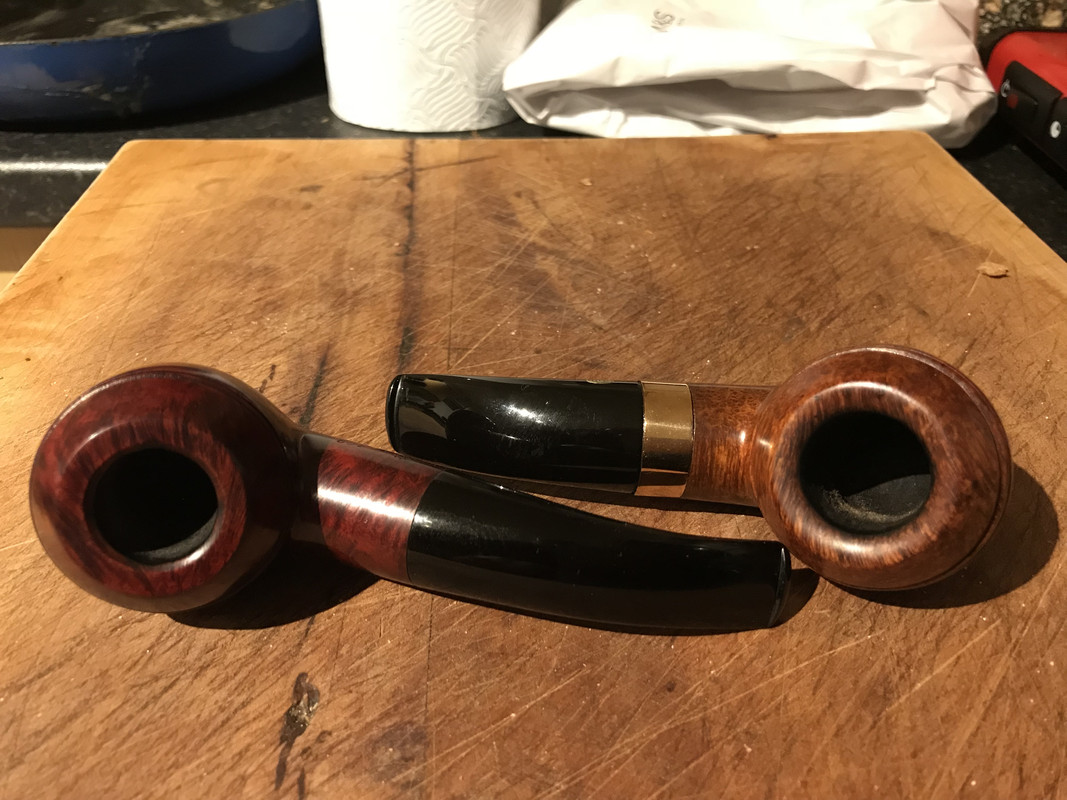
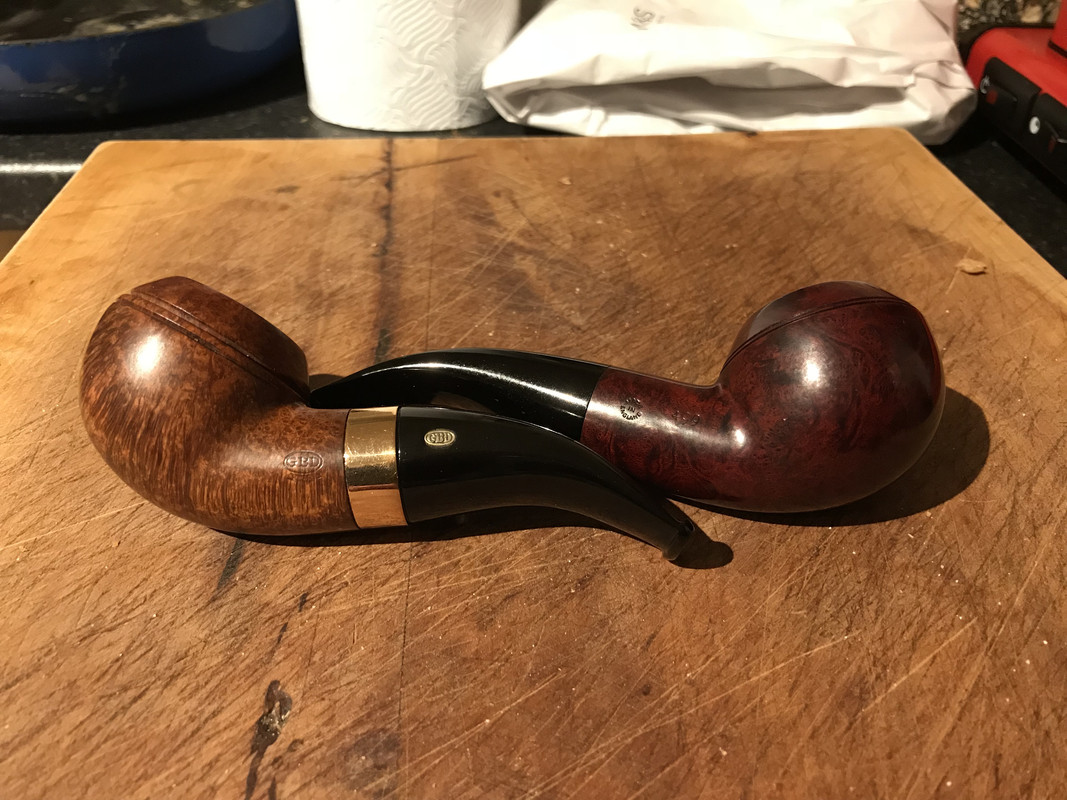
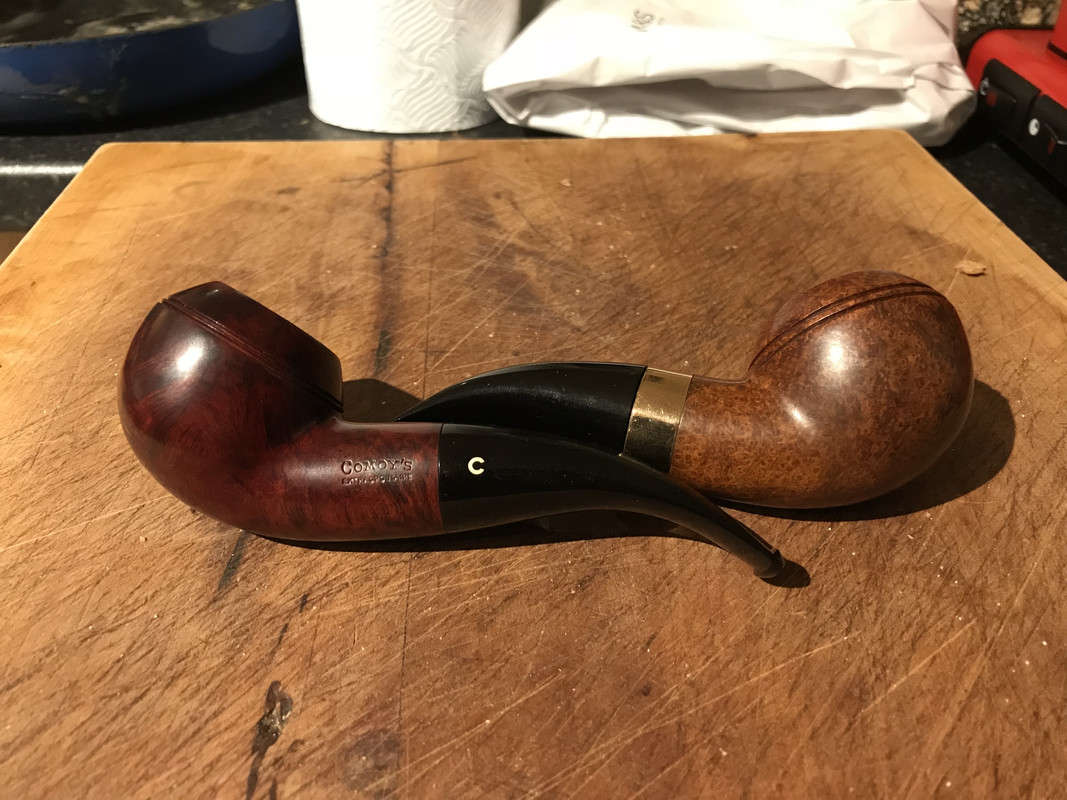
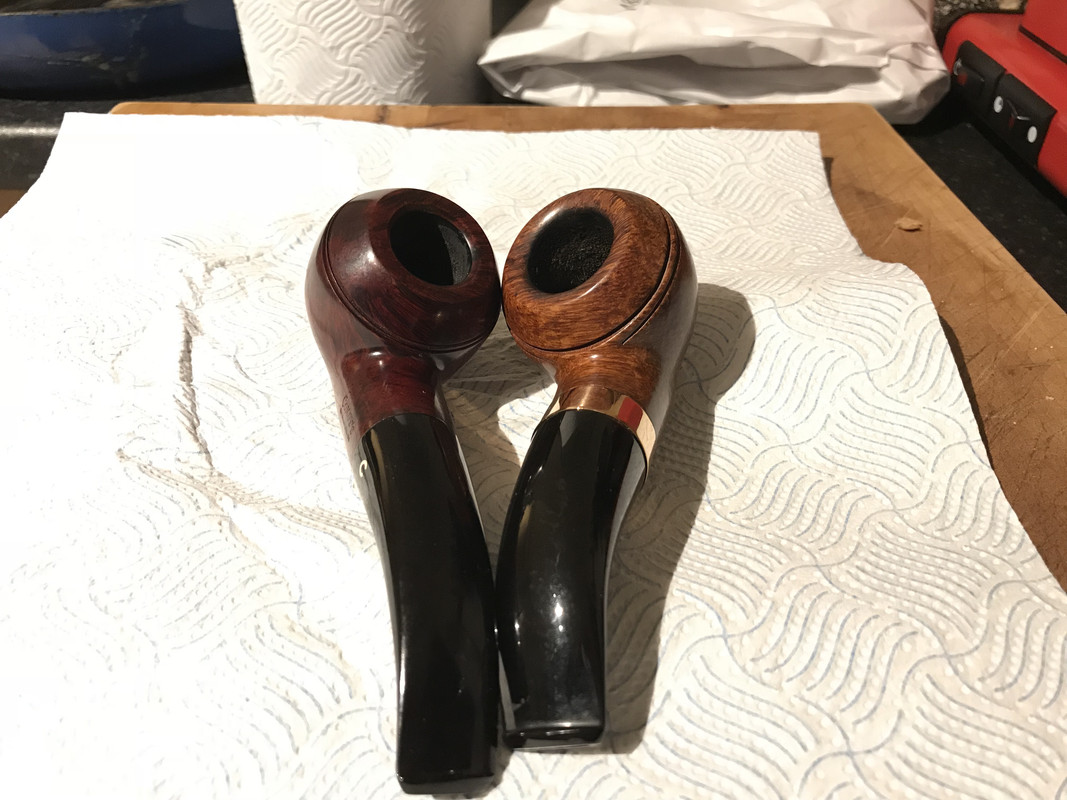
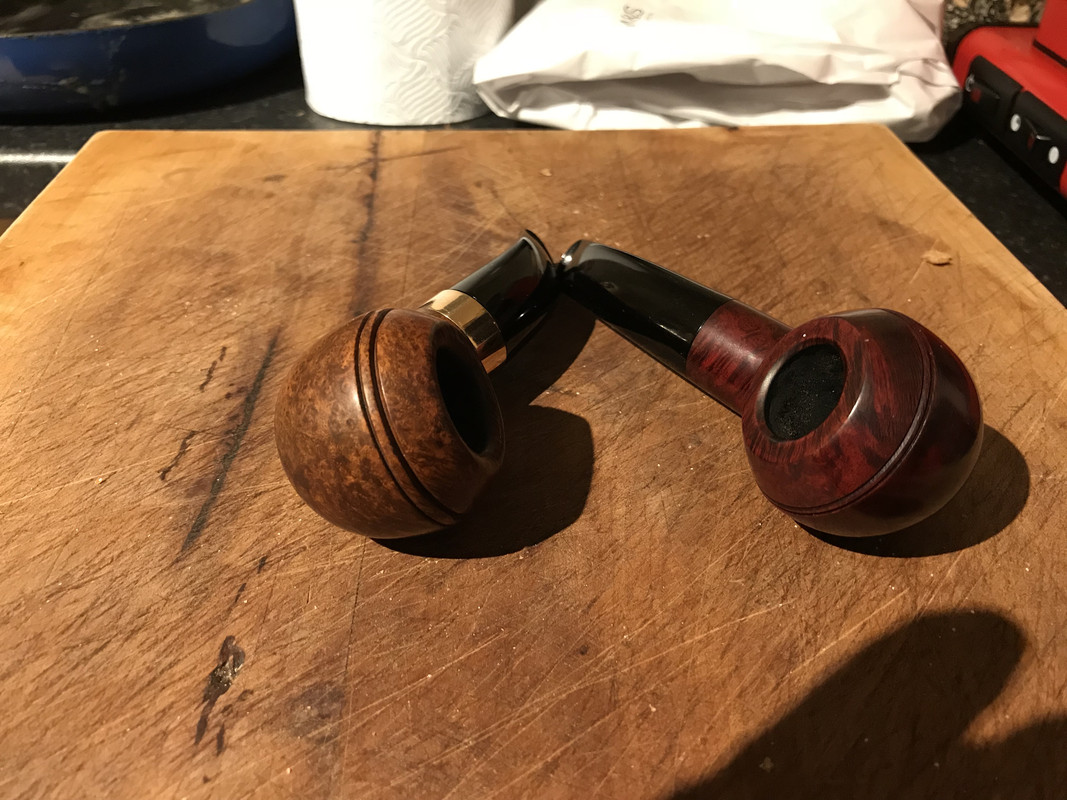
The 9242 is as fat as the 499 and the bowl may be taller but it is shorter.





Thanks for the comparison pics, Achtman and Anthony. Granted, we're comparing a 9242 with a Comoy 499...and I feel bad now having hijacked this thread to draw attention to the similarity in shape, as well as how the 9242 shape was not consistent through the years. I recently bought (and sold) a GBD New Standard 9242, and was shocked at how slender and long it was when I received it; it was unsmoked, with the original trademarked stem. (Could be that a GBD 9242 historian has already pointed this out and explained on another thread). The comparison below is not quite as stark as it would be if comparing to the New Standard that I had...but even at these slightly different angles, you'll see the differences in the short/stocky vs the long/slender versions here. (both stamped GBD / 9242).


Please forgive the rabbit trail I've taken us down. Certainly didn't intend to take the spotlight off of the 499 refurb work Anthony posted about.


Please forgive the rabbit trail I've taken us down. Certainly didn't intend to take the spotlight off of the 499 refurb work Anthony posted about.
I'm late in on this one! Fantastic job.
The 3 piece drilled C is the thing that always makes me marvel about a Comoy's pipe. Can you imagine them making hundreds of those stems per day? Neill Archer Roan tells me they used a drilling jig, but as far as I know, no pictures exist of this factory process.
Dating:
I have an identically stamped 499 Extraordinaire - the "Made in England" COM was used in the 1930's, certainly before WWWII
Size
I have a two GBD 9242's (Sandblast & Hallmarked '37 R9239), they each have identical specs
The 9242's are incrementally smaller in all dimensions, see below
The later era 9242 is slightly larger and longer, weighing 58 grams
9242 specs
Weight - 48 grams ('37 9249 is 53 grams)
Bowl Width - 40 mm
Bowl Height - 40.5 mm
Shank Width - 23 mm
499 Specs
Weight - 68 grams!
Bowl Width - 45 mm
Bowl Height - 42
Shank Width - 26 mm
I've never seen a 499 that wasn't stamped "Extraordinaire". Some Comoy's shapes are always stamped Extraordinaire (the other one escapes me). I suspect the 499 is in that group.
Both pipes.

The 3 piece drilled C is the thing that always makes me marvel about a Comoy's pipe. Can you imagine them making hundreds of those stems per day? Neill Archer Roan tells me they used a drilling jig, but as far as I know, no pictures exist of this factory process.
Dating:
I have an identically stamped 499 Extraordinaire - the "Made in England" COM was used in the 1930's, certainly before WWWII
Size
I have a two GBD 9242's (Sandblast & Hallmarked '37 R9239), they each have identical specs
The 9242's are incrementally smaller in all dimensions, see below
The later era 9242 is slightly larger and longer, weighing 58 grams
9242 specs
Weight - 48 grams ('37 9249 is 53 grams)
Bowl Width - 40 mm
Bowl Height - 40.5 mm
Shank Width - 23 mm
499 Specs
Weight - 68 grams!
Bowl Width - 45 mm
Bowl Height - 42
Shank Width - 26 mm
I've never seen a 499 that wasn't stamped "Extraordinaire". Some Comoy's shapes are always stamped Extraordinaire (the other one escapes me). I suspect the 499 is in that group.
Both pipes.

The 802 is always stamped "Extraordinaire", primarily for size I assume as some are sandblasted.
DocWatson (Andy Camire) sold a sandblasted 499 at the last Richmond show (which i missed by 10 minutes!). But I never asked him if it was stamped Extraordinaire.
DocWatson (Andy Camire) sold a sandblasted 499 at the last Richmond show (which i missed by 10 minutes!). But I never asked him if it was stamped Extraordinaire.
I'm 99.9999% sure that "bullseye" rod was used. Meaning white rod that was manufactured with a black center. That would make the stem drilling performed on the Comoy's shop floor exponentially easier, faster, and more reliable for a long list of technical reasons.The 3 piece drilled C is the thing that always makes me marvel about a Comoy's pipe. Can you imagine them making hundreds of those stems per day? Neill Archer Roan tells me they used a drilling jig, but as far as I know, no pictures exist of this factory process.
Please forgive the rabbit trail I've taken us down. Certainly didn't intend to take the spotlight off of the 499 refurb work Anthony posted about.
It's all good, Joe. The discussion is what makes the thread worthwhile. Otherwise, it's just photos of the same pipe shot twice.
Here's a somewhat older example of a 499 that sold recently...

The stummel dimension appear to be the same, but the stem profile seems to be a little shorter and stouter.
I'm 99.9999% sure that "bullseye" rod was used. Meaning white rod that was manufactured with a black center. That would make the stem drilling performed on the Comoy's shop floor exponentially easier, faster, and more reliable for a long list of technical reasons.
I've wondered about this. I've never seen a factory inlay that wasn't dead center. Damn tricky to do one-by-one in a production environment with such small rod.
The inner core is definitely vulcanite, but I'd like to know what the white, outer material is. I know that it's water-permeable because I've heard stories of stems being soaked and that material softening and deteriorating. So, I've guessed that it's something clay-like, but I really have no clue.
Neill used to have a stem logo essay on his blog, but now lost to time. I believe that he asserted the logo was made from three different rods. (thus the drilled, 3 piece term)
That's amazing. I find it hard to believe it's even the same pipe.
Outstanding work once again.
Hmm I did find this article on the 3 part C:
https://rebornpipes.com/2014/03/11/on-making-a-comoys-c-logo-jacek-a-rochacki/
Outstanding work once again.
Hmm I did find this article on the 3 part C:
https://rebornpipes.com/2014/03/11/on-making-a-comoys-c-logo-jacek-a-rochacki/
I believe I found the link to the article Al mentions on the wayback machine but it wasn't in the archive.
The article was called "On Comoy stems and manufacturing processes"
It's a shame he took down his blog. Does anyone happen to have a copy of that blog post?
The article was called "On Comoy stems and manufacturing processes"
It's a shame he took down his blog. Does anyone happen to have a copy of that blog post?
I never have either.I've never seen a factory inlay that wasn't dead center.
And because of how the human eye/brain mechanism works, the misalignment of concentric circles is detectable by everyone to sub-thousandths of an inch without magnification. (Check out how & why peep sights work on firearms)
I'm going to go farther and say virtually impossible. The first rod, the white one, would have to be fitted AND FINISHED before being drilled itself. And the slightest deviation from dead flat & square would cause the small, center dot's drill bit to skid/deflect/bend (drill bits that size are astonishingly flexible) resulting in an off-center result.Damn tricky to do one-by-one in a production environment with such small rod.
This sort of precision is my passion. I have a Swedish drill press w/4 ten-thousandths quill runout, a high precision Japanese x-y table, use the best jeweler's drill bits available, work under focused halogen lights and high head-worn magnification, have lots of practice with all of it... and doing a 3-piece C is still stressful.
Never mind that Comoy's entire assembly line would stop every time the 3-piece C guy took a day off or got sick (that multiple people were able to do it interchangeably is hard to imagine), the rate of production when he WAS there would be laughably slow. 10-12 stems per shift. Maybe.
And don't forget zero errors allowed past QA. Visibly off-center by any amount whatsoever, into the bin it goes.
Use bullseye rod, though---which is nothing unusual, special, or expensive to obtain---and ALL the above goes away. Poof. The job then is just two overlapping dots, the first of which can be placed anywhere, and the second only needs to be close. The task changes from requiring extraordinary effort to routine.
Ah, perhaps it was the Derek z Green article I'm remembering. Neill also had someone made him a 3 pc stem logo and referenced the process.
I exchanged some Facebook messages with Neill this afternoon. He had this to say about the way the logo was drilled (three piece versus two):
I know they used three drillings. And three pieces. I spoke at length with the last president of Comoy about the three-part C logo, how it was made.
I've handled perhaps 100 or so Comoy's in the past seven years and I've only seen one with a wonky-drilled C (one of Dave Jacobsens recent KS pipe show purchases. Neill is as close to an authority that we have on Comoy's pipes, which seems to be supported by the detail in Derek Green's "Dating Guide". So, I'll have to take his word on it. (plus I want to believe that some fool drilled thousands of pipes three times!)there is so much variation in the way the logos were executed. I've seen them off center, which wouldn't be possible with bullseye rod.
Inlaid “C”
“C” was first inlaid in the side of the mouthpiece around 1919. This was a complex inlay needing three drillings. First, a round white inlay was inserted, then the centre of the white was drilled out, and a smaller round black inlay was inserted. Finally, another drilling was made to remove the open part of the “C,” and an even smaller black inlay was inserted. This inlaid “C,” known as the “three-piece C,” was continued until the Cadogan era in the 1980s. However, the “C” in the 1920s and early 30s was much thinner and more delicate than the one post-war. Cadogan first changed the “C” to a single drilling with an inlay that had the “C” in the centre, and more recently it became a laser imprint. I have a cased pair of early 1920’ “Par Excellence” where the “C” is on top of the mouthpiece.
@woods: Since that pipe wasn't purchased new, anything is possible!
Since most of us have not seen virtually any off-drilled logo pipes, that sure says a lot about Comoy's QC.
Since most of us have not seen virtually any off-drilled logo pipes, that sure says a lot about Comoy's QC.
- Status
- Not open for further replies.







